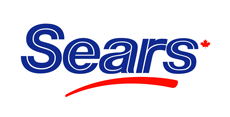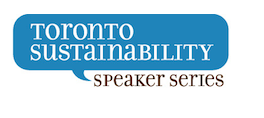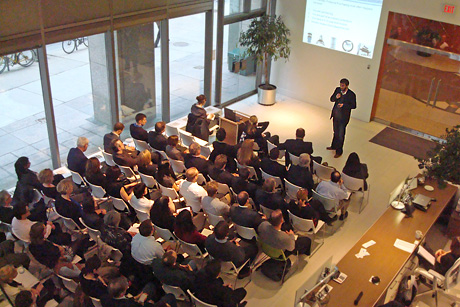 Companies know that a coordinated sustainability initiative is a business imperative. But how do you implement your sustainability initiative? Where does sustainability fit within the corporate structure? How do you overcome the inevitable challenges? Sustainability Leader of Sears Canada James Gray-Donald opens his playbook and shares the challenges and successes of leading Sears towards greater sustainability.
Companies know that a coordinated sustainability initiative is a business imperative. But how do you implement your sustainability initiative? Where does sustainability fit within the corporate structure? How do you overcome the inevitable challenges? Sustainability Leader of Sears Canada James Gray-Donald opens his playbook and shares the challenges and successes of leading Sears towards greater sustainability.
For a sustainability initiative to succeed, the sustainability message must permeate the organization and be supported by company leadership. If your sustainability leader(s) are isolated within a particular division of the company (e.g. marketing), then success will be limited. Sustainability leaders must understand how their initiatives can be presented and achieved within the context of business as usual while also learning from global best practices to reach beyond business as usual.
At a recent Toronto Sustainability Speaker Series event, Gray-Donald of Sears Canada opens his sustainability playbook. Using examples from Sears Canada, as well as other companies, Gray-Donald showed it is not enough to embark upon an internal corporate sustainability journey, but upstream and downstream impacts must also be considered. For example, when National Geographic magazine embarked upon its sustainability journey, they implemented a number of internal initiatives to reduce their environmental impact; their corporate culture of sustainability developed, and employees became committed to the endeavour. They were surprised by the findings of a detailed carbon footprint analysis that about 70% of their carbon footprint came during the paper production stage. This upstream impact revealed that a single individual (who was not necessarily on their green team) was most able to increase or decrease the whole magazine’s footprint through which paper mill was selected. The lesson is that a successful sustainability initiative needs not only a vision but also corporate commitment that includes procurement and is visible to each employee.
 To understand the importance of downstream impacts for retail business operations, Gray-Donald shared data collected by Marks and Spencer UK. Their downstream impacts were about four times their internal footprint. For example, the annual carbon footprint of M&S direct operations (e.g. energy use, travel, etc.) was only about 10% more than the footprint of their consumers ironing the M&S clothing they had bought that year.
To understand the importance of downstream impacts for retail business operations, Gray-Donald shared data collected by Marks and Spencer UK. Their downstream impacts were about four times their internal footprint. For example, the annual carbon footprint of M&S direct operations (e.g. energy use, travel, etc.) was only about 10% more than the footprint of their consumers ironing the M&S clothing they had bought that year.

Sears Canada recognizes that the scale of its upstream and downstream impacts are significant, and is focused on helping its customers save energy – and money – by energy efficient upgrades. Sears has won Energy Star Retailer of the Year the past 3 years in a row and has launched innovative tools such as the Cost and Carbon Calculator to help Canadians understand how they can lower their utility bills. Nevertheless, the company recognizes the importance of reducing the impact of its internal operations to be credible within the sustainability space. The Company has set targets to reduce its carbon footprint by 20% below 2007 levels by 2013. Its trucking fleet has been SmartWay certified for over five years, and there has been a 1-3% annual improvement in fuel efficiency. Electricity consumption in its buildings is 15% less than in 2007. Green teams have been established in all stores across the country, which gives employees a feeling of legitimacy in implementing their own initiatives. One amusing example of energy reduction combined with corporate culture building and employee engagement was the story Gray-Donald shared of the ‘retirement’ of a staff room fridge (in favour of a more energy efficient model) – a party was held in its honour, ‘fridge whisperers’ soothed the appliance through its journey, and caring farewell messages were scrawled with marker on the fridge before it made its final journey to a responsible appliance recycling facility.
Sears Canada has faced many challenges in its sustainability journey. Gray-Donald explained the value of pilot programs: “If you’re going to fail, fail fast.” He shared that he has defined 164 performance indicators; while some of these have yet to be addressed, they remain on his ‘wish list’. He shared his belief that 99% of people want to do the right thing, but they don’t always have the knowledge or tools needed; education of both staff and consumers is vital.
Retail business is about making money and consumers continue to demand more for less. Educating consumers so that they will consciously choose sustainable products is part of achieving a true sustainability vision. While Gray-Donald believes that sustainable companies should be extending and stretching further than what people expect and know, he acknowledged that Sears is not always able to reach as far as he would like. It is that constant drive for improvement that motivates leaders in sustainability. It is important to bring vision, ethics and corporate social responsibility into decision making but messaging cannot push too far beyond where consumer beliefs and understanding are positioned. (See Green Marketing interview with Jacquie Ottman). As such, most marketing messages are only effective if consumers “get it” in five seconds or less.
Gray-Donald explained a corporate sustainability leader must be strategically opportunistic and interested in learning. A passion for learning allows you move beyond business as usual to see where you can have the most impact, how your organization aligns with your sustainability vision and what market conditions will enable your vision. When you are strategically opportunistic, you can take advantage of situations as they arise. An example of this was the ability of Sears to negotiate effectively with paper suppliers when paper prices were at a low point in the market.
Another example of strategic opportunism began with a story of failure. Sears tried to sign up customers at stores for its Home Energy Tune Up, but had little success; low engagement among staff at the booth yielded poor results. However, when Sears seized the opportunity to promote the Tune Up during Toronto Hydro’s in-store power bar giveaway, they signed up hundreds of people. Successful initiatives require not only a good idea but also an unwavering commitment to creatively overcome challenges and obstacles as they arise; the results of such efforts often exceed expectations.
Sears Canada has embedded sustainability strategies into its business operations. They work to engage and empower both their associates and their customers, to share and learn from NGOs and industry partners, to be strategically opportunistic and to get the analytics right while always maintaining passion for the cause. They prioritize initiatives based on an understanding of where they can achieve the most material impacts, current and expected market conditions and their own organizational strengths. Sears Canada defines as its mission “to build customer relationships, make more money, and improve every day”. Their evolving sustainability journey is a vital part of this mission. Sears Canada understands that sustainability is about doing the right thing for the triple bottom line: people, planet and profits.

[…] while transportation-related initiatives were commonly cited. (See case studies on Coca-Cola, Sears, Unilever, […]
[…] while transportation-related initiatives were commonly cited. (See case studies on Coca-Cola, Sears, Unilever, […]
[…] Image taken from: www.carbon49.com […]